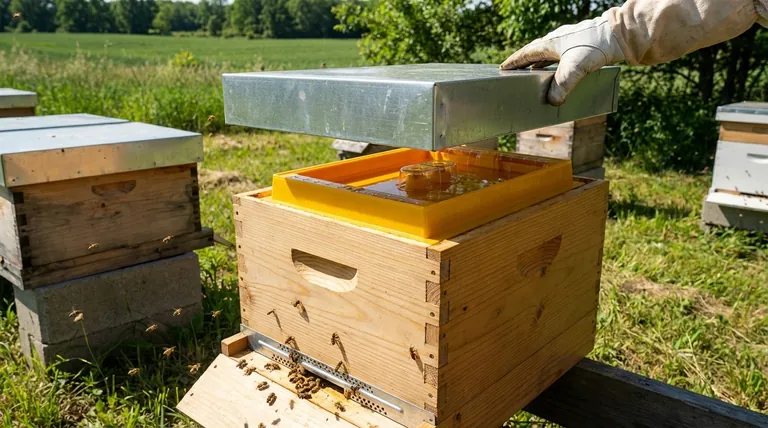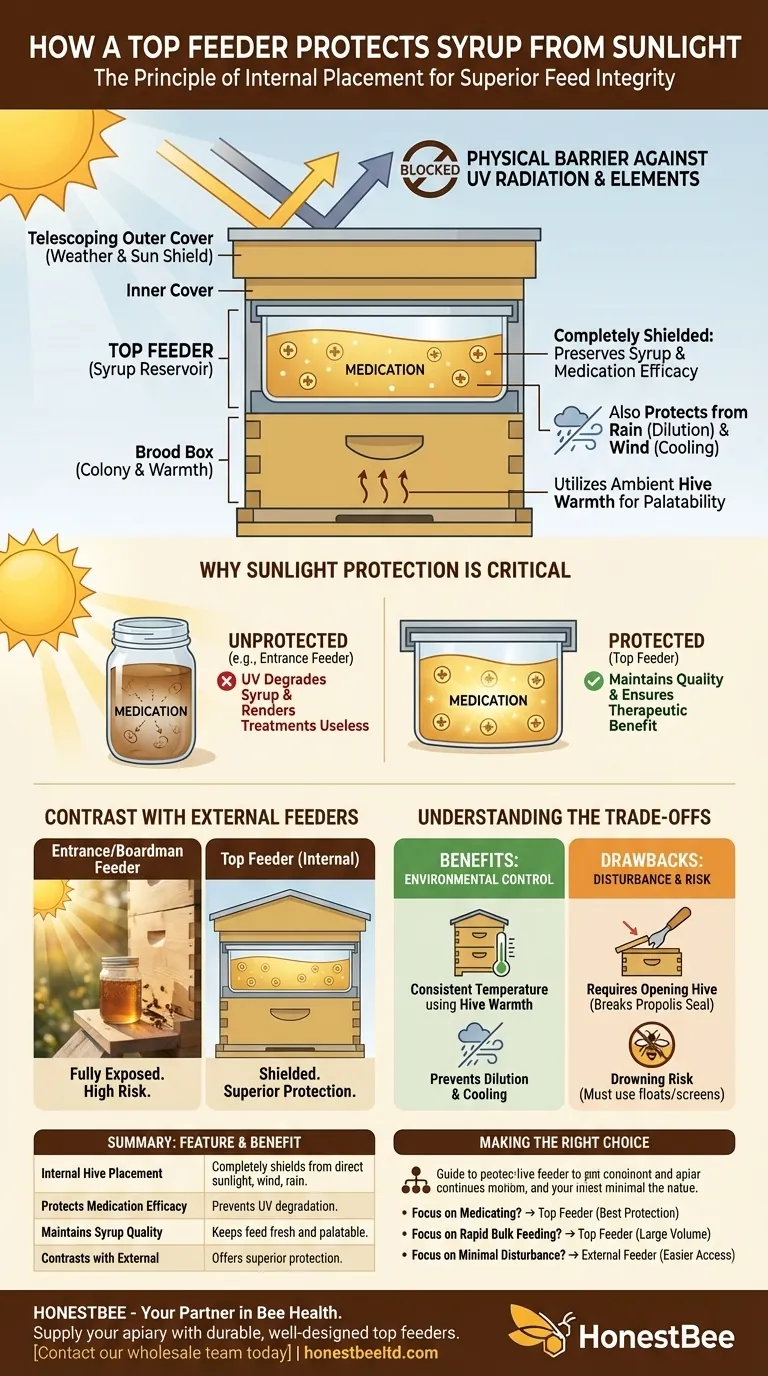The primary way a top feeder protects syrup is through its placement. Because it sits directly on top of the brood boxes but underneath the telescoping outer cover of the hive, it is completely shielded from direct sunlight, as well as wind and rain.
A top feeder’s internal placement is its key design advantage. By shielding syrup from the elements, particularly sunlight, it preserves the integrity of the feed and ensures the efficacy of any medications mixed within it.

The Principle of Internal Placement
A Physical Barrier Against Sunlight
A standard Langstroth hive is designed with an inner cover and a telescoping outer cover. The top feeder is positioned below both of these layers.
This multi-layer system creates a complete physical barrier. No direct sunlight can penetrate the outer cover to reach the syrup reservoir inside the feeder.
Why Sunlight Protection is Critical
Sunlight, specifically UV radiation, can degrade sugar syrup over time. More importantly, it can rapidly reduce the effectiveness of common hive treatments and medications.
If you are using medicated syrup, such as for treating Nosema or controlling mites, exposure to sunlight can render the treatment useless. The bees would consume the syrup without receiving the intended therapeutic benefit.
Contrast with External Feeders
This internal protection is a significant advantage over external feeders, like entrance feeders (Boardman feeders).
Entrance feeders, while easy to monitor and refill, sit outside the hive. Their glass or plastic jars are fully exposed to the sun, putting the syrup and any medications at risk of degradation.
Understanding the Trade-offs
The Benefit of Environmental Control
By being inside the hive, the top feeder not only protects syrup from sunlight but also from rain, which can dilute it, and wind, which can cool it. The ambient warmth of the hive cluster keeps the syrup at a more palatable temperature for the bees.
The Drawback: Hive Disturbance
The primary disadvantage of a top feeder is the need to open the hive for refills. This involves removing the outer and inner covers, which breaks the propolis seal and disturbs the colony.
This disturbance can be stressful for the bees, especially in cooler weather. It also exposes the beekeeper to the colony's guard bees.
Drowning Risk
If not designed or set up properly, top feeders can pose a drowning risk. It is essential to use a model that provides floats, screens, or a well-designed access channel that prevents bees from falling into the main syrup reservoir.
Making the Right Choice for Your Goal
Choosing a feeder depends entirely on your specific objective. The top feeder's design makes it ideal for certain situations but less so for others.
- If your primary focus is medicating: The top feeder is the superior choice to protect the treatment's efficacy from sunlight.
- If your primary focus is rapid bulk feeding: Its large volume and protection from the elements make it highly effective for quickly building up a colony.
- If your primary focus is minimal disturbance: An external entrance feeder or a frame feeder refilled during regular inspections might be a better fit.
Ultimately, understanding how a feeder's placement impacts the feed is fundamental to effective beekeeping.
Summary Table:
| Feature | Benefit |
|---|---|
| Internal Hive Placement | Completely shields syrup from direct sunlight, wind, and rain. |
| Protects Medication Efficacy | Prevents UV degradation of treatments for Nosema or mites. |
| Maintains Syrup Quality | Keeps feed fresh and at a palatable temperature using hive warmth. |
| Contrasts with External Feeders | Offers superior protection compared to exposed entrance feeders. |
Ensure your colonies receive the full benefit of their feed and medication.
At HONESTBEE, we supply durable, well-designed top feeders and other essential beekeeping supplies to commercial apiaries and distributors. Our equipment is built to protect your investment in bee health and productivity.
Ready to upgrade your feeding strategy? Contact our wholesale team today to discuss your needs and explore our full product catalog.
Visual Guide

Related Products
- Professional Hive Top Bee Feeder for Beekeeping
- HONESTBEE Round Hive Top Bee Feeder for Syrup
- Rapid Bee Feeder White Plastic 2L Round Top Feeder for 8 or 10-Frame Bee Hives
- Professional Hive Front Entrance Bee Feeder
- HONESTBEE Professional Hive Top Bee Feeder Feeding Solution
People Also Ask
- What are the features of top feeders for bees? Maximize Hive Health with Safe, High-Capacity Feeding
- What are the advantages of using top feeders for bees? Maximize Feeding Efficiency & Colony Safety
- Do I need an inner cover with a hive top feeder? Optimize Your Hive Setup for Healthy Bees
- What types of hive boxes is the round hive top feeder compatible with? Universal Fit for 8 & 10-Frame Langstroth Hives
- How is the plywood floor fitted into the hive-top feeder? Ensure Longevity with a Floating Floor Design



















